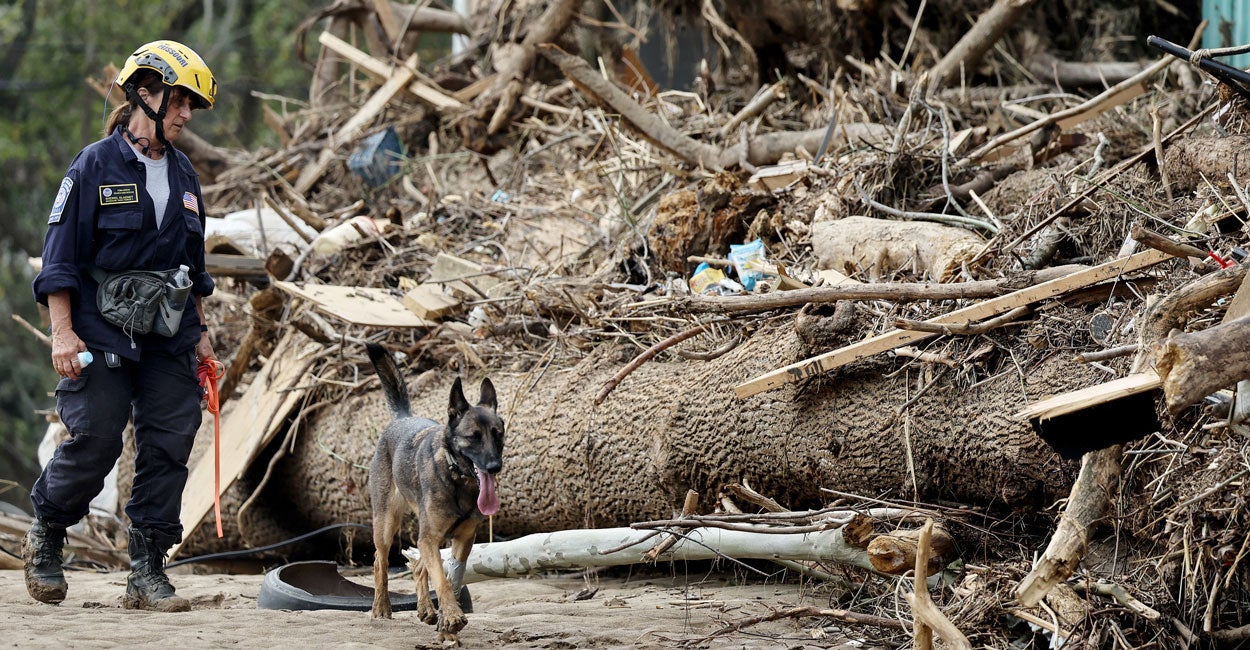Hurricane Helene Response Highlights Biden and Harris’ Failure to Lead
In the wake of a catastrophic disaster, effective leadership and a rapid, coordinated response are critical to mitigating the impacts and restoring public confidence. That’s... Read More The post Hurricane Helene Response Highlights Biden and Harris’ Failure to Lead appeared first on The Daily Signal.

In the wake of a catastrophic disaster, effective leadership and a rapid, coordinated response are critical to mitigating the impacts and restoring public confidence.
That’s not what is happening.
The aftermath of Hurricane Helene, which made landfall as a Category 4 storm and caused catastrophic flooding in North Carolina, has revealed significant gaps in the federal response. From strained resource deployment to absent leadership, the response to Hurricane Helene serves as a stark reminder of how quickly disaster management can falter when clear direction and visible leadership are lacking.
The absence of President Joe Biden and Vice President Kamala Harris during the height of the disaster response has set a troubling tone, raising questions about the federal government’s ability to handle large-scale emergencies and putting a spotlight on the critical role that leadership plays during moments of crisis.
Hurricane Helene made landfall on Thursday evening, battering coastal regions with intense winds, storm surges, and heavy rainfall. FEMA quickly mobilized resources and state-level response teams to address the immediate impacts on North Carolina’s coastline, where the devastation was most visible.
However, as the storm moved inland, it unleashed torrential rains and flash flooding in communities far from the coast. By Saturday, North Carolina’s inland regions were facing catastrophic flooding, and yet the federal response struggled to keep pace. As FEMA faced the challenge of reallocating resources—already stretched thin from the initial surge to coastal areas—many communities were left vulnerable as they waited for relief.
While logistical challenges in relocating frontline resources are to be expected, especially during widespread disasters, there is no excuse for the absence of visible leadership from the nation’s highest offices.
When resources are delayed or overwhelmed, it becomes even more important for administration officials to step forward, demonstrate accountability, and provide clear direction. Visible leadership from the president, vice president, and other key officials can reassure the public that the government is taking swift, decisive action to address the crisis. However, when that leadership is absent, as was the case during Hurricane Helene, the optics of failure begin to take hold.
Biden and Harris’ failure to demonstrate visible leadership over the weekend of the disaster is a prime example of how quickly perceptions can turn. Despite the storm making landfall on Thursday evening and devastating inland North Carolina by Saturday, Harris chose to attend political fundraisers, while Biden remained at his beach home in Rehoboth Beach, Delaware. Their absence from public view during such a critical moment sent the wrong message to those suffering in North Carolina and to the nation. Furthermore, the lack of engagement from the administration leaves many questioning the federal government’s commitment to addressing the crisis.
This response is emblematic of this administration’s failed attempt to lead. The administration has prioritized DEI and climate change ‘feel good’ policies implemented by equity advisors and taskforces while allowing mission-critical roles and training to languish.
In times of disaster, Americans look to their leaders for reassurance, direction, and empathy. When President George W. Bush was slow to respond to Hurricane Katrina, it set a precedent for how a lack of visible leadership can irreparably harm an administration’s credibility. The response to Hurricane Helene is drawing similar comparisons. Between fundraisers and beach weekends, the administration’s priorities appeared out of step with the urgency of the disaster response. Biden and Harris’ absence at a time when leadership was most needed has set the stage for criticism and frustration, particularly among those in the hardest-hit areas who were looking for a sign that help was on the way.
Disasters require more than just operational responses—they require leaders to be present, engaged, and visible. The failure of President Biden and Vice President Harris to demonstrate leadership during Hurricane Helene not only left a vacuum in public perception but also has affected the tone of the entire federal response.
As FEMA struggled to surge resources to inland areas, the absence of top officials reinforced the narrative that the federal government was disconnected from the realities on the ground. The consequences of this leadership vacuum will not only affect the administration’s standing but also the overall effectiveness of future disaster responses.
In the end, Hurricane Helene has highlighted both the logistical and leadership challenges that come with managing large-scale disasters. While FEMA’s ability to surge resources is always tested in these moments, it is the responsibility of the nation’s leaders to show that they are actively engaged in the response. The failure to do so during Hurricane Helene, particularly by Biden and Harris, has set a troubling precedent.
If the federal government is to regain the trust of the American people in its disaster management capabilities, it must prioritize not only operational readiness but also visible, accountable leadership in the face of crisis. Instead, the administration’s focus on peripheral priorities like DEI and climate change at the expense of mission-critical functions has only exacerbated the growing concern over the federal government’s ability to respond effectively when it truly matters.
The post Hurricane Helene Response Highlights Biden and Harris’ Failure to Lead appeared first on The Daily Signal.
What's Your Reaction?


























:quality(85):upscale()/2024/09/09/785/n/1922283/901e710666df358b373de2.40207443_.jpg?#)
:quality(85):upscale()/2024/07/23/904/n/1922283/dc92642c66a0159ee98db4.72095370_.jpg?#)
:quality(85):upscale()/2024/07/10/842/n/1922283/8fb902af668edd399936b2.17277875_.jpg?#)
:quality(85):upscale()/2024/06/07/909/n/1922283/82a389f8666372643f2065.06111128_.jpg?#)
:quality(85):upscale()/2024/06/07/726/n/1922283/10bee64e666334778cf548.63095318_.jpg?#)
:quality(85):upscale()/2025/02/03/788/n/1922283/010b439467a1031f886f32.95387981_.jpg)
:quality(85):upscale()/2025/01/08/844/n/1922398/cde2aeac677eceef03f2d1.00424146_.jpg)
:quality(85):upscale()/2024/11/27/891/n/1922398/123acea767477facdac4d4.08554212_.jpg)
:quality(85):upscale()/2024/12/02/919/n/1922398/2b4b75f6674e20edcc99c3.42112799_.jpg)
:quality(85):upscale()/2024/10/29/690/n/1922398/e9bec6b46721006258d949.01358236_.jpg)












